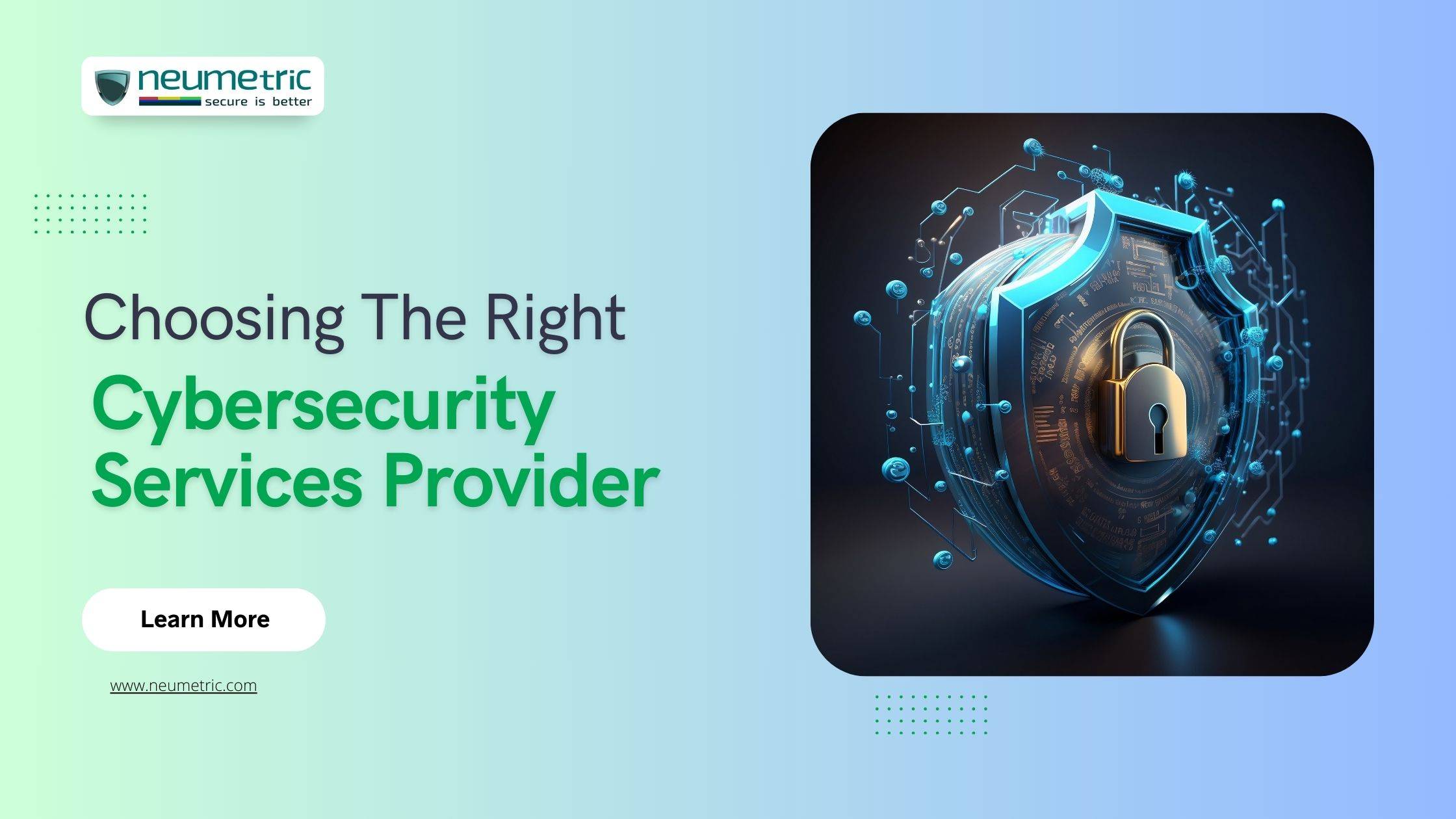Table of Contents
ToggleIntroduction
The risk of cyberattacks & data breaches have increased exponentially in recent years. As businesses rely more on technology & digital workflows, securing critical assets & data from malicious actors is imperative. Partnering with the right cybersecurity services provider can help safeguard operations & instil resilience. This Journal outlines key considerations for businesses evaluating & selecting such providers to meet their needs.
First, we explore the value of cybersecurity in today’s digitally driven marketplace & increasingly treacherous threat landscape. Next, an overview is provided of the diverse services offered by providers to reinforce defences. Core factors for comparison are then covered – spanning expertise, service scope, repute & more. Guidance is shared on gauging security protocols, costs & return on investment. Finally, emphasis is placed on the need for rigorous assessment to choose a provider that aligns with business risk profiles & security priorities.
Understanding your business’s cybersecurity needs
Before evaluating vendors, companies must review their existing infrastructure, identify exposures & determine cyber risk appetite. A risk assessment gauges current safeguards & vulnerabilities across networks, endpoints, data repositories, business applications etc. It pinpoints security gaps requiring attention from tools, policies to employee practices. Understanding shortcomings & weak links arms with cyber priorities.
Specific threats relevant to the company’s industry, operations & data sensitivity should be analysed next. For instance, Intellectual Property [IP] theft may be a major concern for a high-tech innovator. Patient record confidentiality may be paramount for a healthcare provider. Such threat modelling allows customization of cyber defences for optimum protection.
Additionally, regulatory & compliance mandates have to be incorporated into the cybersecurity program. Adhering to regulations like HIPAA in healthcare, PCI DSS for payment companies or privacy laws like GDPR is critical as infractions bring steep fines.
Factors to consider when choosing a cybersecurity services provider
With organisational needs & risk parameters mapped, the process of identifying the right partner can begin through comparison across a few key yardsticks:
Expertise & experience: Foremost, providers must display deep cybersecurity knowledge & extensive experience defending organisations similar to yours. Evaluating successful track records with past clients is invaluable. The competency of in-house teams & talent pool should be analysed as well through qualifications & industry certifications like CISSP. High client retention rates also validate technical proficiency.
Additionally, providers accumulating niche expertise & credentials in serving sectors like finance or healthcare may suit companies therein. Alignment of specialisations to business needs often improves risk mitigation.
Range of services offered: Thereafter, the spectrum of offerings should be weighed in relation to internal gaps. Many providers offer bundled suites spanning monitoring & analytics, threat intelligence, incident response & forensics, cyber awareness training etc. Based on growth objectives, scalable solutions allowing fluid access to additional capabilities are preferred.
Technology & tools: The underlying technology infrastructure enabling service delivery should integrate well without conflicting with existing environments. For instance, endpoint security platforms may require compatibility assessments before onboarding. APIs for real-time data transfer may need configuration adjustments too. The right tools, systems & ethical hacking techniques can bolster defence substantially.
Reputation & client references: Furthermore, client reviews & testimonials serve as credible indicators of provider competence. Referrals from business associates on service satisfaction levels lend trust. Case studies outlining cyber protections developed for companies in the same sector can indicate customization capacities. Such feedback furnishes a clearer picture.
Assessing security measures & protocols
Gauging information security protocols & protections applied by providers is equally critical for risk mitigation. To start, the defence-in-depth philosophy adopted should incorporate multiple control layers spanning network, cloud, endpoints etc. Robust identity & access governance, advanced malware prevention, Multi-Factor Authentication [MFA], VPNs, NextGen firewalls all progressively raise the barrier against threats. Analytics-based threat detection & rapid response capabilities add resilience.
On the data security side, sophisticated encryption & tokenization limit unauthorised access in case of attacks. Secure key management practices provide added assurance. Background screening of provider staff handling sensitive data inspires confidence in integrity measures as well.
Furthermore, clear incident response plans & disaster recovery protocols in the event of breach or outage also lend peace of mind that business continuity safeguards are in place.
Cost & Return on Investment [ROI]
Pricing transparency, reasonable total cost of ownership & ROI projections should assist selection. Subscription models with predictable fees based on customizable service bundles offer flexibility for businesses. Free trial runs can determine effectiveness before purchase.
Overall ROI should outweigh expenses in terms of reduced data breach & malware attack risks, averting customer trust erosion & financial fraud. When weighted against potential business disruption, regulatory non-compliance penalties or cyberattack recovery costs of hundreds of thousands of dollars, reasonable cybersecurity investments pay rich dividends.
To determine TCO, direct service fees should be evaluated against indirect overheads like technology upgrades needed to leverage solutions fully. The costs of employee training sessions on updated tools & policies also add up. Pricing models allowing bursting into premium capabilities like forensics & compliance reporting during crises provide cost-efficiency.
Carefully structured SLAs aligning performance incentives with business impact parameters also provide financial upside. Agreement clauses mandatory breach disclosure within fixed timelines, institute penalties for delays. Compensations for unmet uptime assurances or incident response lag equally share risk. Such outcome-based pricing builds in reciprocity for both parties to optimise protections.
Applying security metrics like lower malware infections, threat containment rates or policy compliance scores offers tangible measures for yearly performance reviews. Benchmarking security program efficacy against industry averages frames progress better to continue or alter strategies. Over time, cyber risk quantification methods like risk registers & actuarial models lend clarity for budgeting.
While framed primarily as safeguards, cybersecurity solutions also unlock productivity & revenue gains – further boosting ROI. Secure connectivity options foster remote work & mobility to reduce costs. Bolstered data integrity spurs customer trust & referral marketing. Cumulatively these lift the business value derived from cyber investments manifold.
Evaluating customer support & communication
The providers’ customer support infrastructure & communication flows merit equal attention for sustained value delivery. Accessibility, responsiveness & understanding of support teams responsible for account & relationship management establish reliable partnerships. Clear reporting lines & channels via phone, email & client portals ensure cyber health monitoring transparency & simplify issue resolution.
Annual or more frequent review meetings, executive briefings, on-demand capacity planning & training resources indicate serious commitment to customer needs.
Maintaining open communication channels between key staff & prompt issue troubleshooting minimises business disruption. Partners offering defined account management processes & named technical contacts inspire confidence. Onboarding sessions, technical documentation portals & online knowledge bases also speed self-service for employees.
In case of attacks or outages, quick notification & mitigation responses limit damages. Partners capable of notifying clients within stipulated response timelines denoted in SLAs indicate reliability. Around-the-clock threat monitoring & support coverage ensure minimal lag between attack detection & containment.
Post-incident analysis reports documenting causes, corrections implemented & measures to prevent recurrence provide closure. Such diligence translates to operational resilience over time through continuous security hardening. Insights from white-glove incident response can be invaluable if contractually packaged with general managed services.
Overall, the criteria of responsive helpdesk teams, transparent health status updates & defined reporting mechanics merit weight in provider selections. Aligned communication rhythms forge durable risk management partnerships able to weather unforeseen storms.
Compliance & regulatory adherence
With cyber laws & compliance obligations expanding, aligning with a provider well-versed in negotiating the regulatory maze is prudent. Key service aspects like data custody, system access controls & employee screening should meet internationally recognized security frameworks like ISO 27001. Privacy regulation observance like GDPR & cross-border data transfer mechanisms add to trust.
Industry-specific certification such as HITRUST CSF in healthcare prove updated regulatory prowess essential for operational continuity & avoiding steep fines. Commitment to figuring optimal ways of adhering to emerging local laws also bespeaks reliability.
Staying atop the complex & frequently updated compliance landscape is a challenging parallel pursuit for most businesses. Requirements like data sovereignty, disclosure rules & breach notification duties often compel procedural realignments. Lacking competent legal interpretations can risk serious fines or lawsuit liabilities. Cybersecurity partners shoulder these regulatory burdens for clients via mandatory certifications, controls mapping to laws & constant policy updates.
For instance, providers with EU/US Privacy Shield accreditation enable lawful cross-border personal data transfers, vital for globalised operations. Contractual guarantees to abide by privacy principles & opt-in requirements ease corporate accountability. Furthermore, partners may offer customised data handling blueprints for transnational business environments. This allows efficiently addressing regional diversity in privacy laws, cultural norms & consumer expectations which impact trust.
In essence, keeping regulatory alignments current across multiple jurisdictions provides strategic advantage. Devolving this obligation together with actualizing policy & system changes needed for legal conformity allows executives to focus on driving growth unencumbered. The alternative of grappling with fluid regulations diverts bandwidth from core business priorities & offers no cost or capability benefits. Thus regulatory fluency should be a key determinant in provider selection.
Conclusion
In closing, meticulously evaluating cybersecurity services partners on a range of parameters will enable picking one strategically equipped to secure business-critical systems & data assets while observing budget. Companies can thereby reinforce resilience against exponentially growing cyber risks through a scalable long-term partnership bound by trust.
The need for cybersecurity readiness cannot be overstated in the current volatile threat climate. As digital transformation accelerates across industries, attack surfaces widen exponentially allowing hackers more entry points. The sophistication of threats also increases constantly, outpacing the ability of in-house security teams to cope. The risks of data theft, integrity loss, crippling outages or insider threats run high, making effective risk transfer mechanisms essential.
Delegating cyber defence to an expert third party alleviates the technology talent & capital drain businesses face in keeping abreast with the breakneck change pace. It allows focusing executive bandwidth on core objectives around growth, innovation & customer value. Economies of scale also enable specialist providers to deliver superior protection at competitive rates. The intangible benefits of brand reassurance, stakeholder trust & mitigation of enterprise risk further boost ROI.
In essence, a seasoned cybersecurity partner with aligned business philosophy & risk outlook can provide the bulwark against adversaries. The guidelines covered herein encompass all essential aspects to evaluate during provider selection – from competence to cost-effectiveness & more. Investing diligently upfront in procurement assessments ultimately rewards with resilient operations & assurance of continuity. For enterprises weighing their data integrity & continuity needs against financial constraints, the cybersecurity partner model arguably emerges as an indispensable ally.
FAQ:
My company operates in a highly regulated sector like finance or healthcare. How can a cybersecurity partner help meet compliance needs?
Sectors with stringent data privacy or confidentiality laws like HIPAA need specialist partners. Top providers in such spaces maintain mandatory certifications like ISO 27001, SOC 2 that map controls to regulations. They stay constantly updated on evolving mandates through advisory networks. This takes the burden off clients. They also offer customised data governance blueprints to fulfil regional statutory needs & training to ensure internal alignment. The key benefit is continuing business free of compliance distractions or fines.
We have limited security staff & budgets right now. What pricing models can help us afford good cyber protection?
Many providers offer flexible buying options to suit different needs & maturity levels. Small firms can access only cloud monitoring, anti-malware & training without huge setup costs. Bundled monthly subscription plans across security layers like email, endpoints, network gateways let you pick suitable tiers. Pay-per-seat & pay-per-use models without fixed user licences also help you scale as you grow by adding specialised capabilities like compliance reporting, DDoS mitigation when required or during heightened risk.
How can we assess if a cybersecurity partner is the right long-term fit for us before signing a contract?
The evaluation stage allows in-depth due diligence into providers’ capabilities, solutions, protocols & support reliability to gauge fit. Review public client reports, press releases on recent threat wins. Schedule conversations with their engineers, account management teams on priorities & challenges. Ask for client references within industries familiar to you. Multi-year contracts often make breakups tedious – so crystallise trust & strategic vision match through prolonged conversations before commitment.





